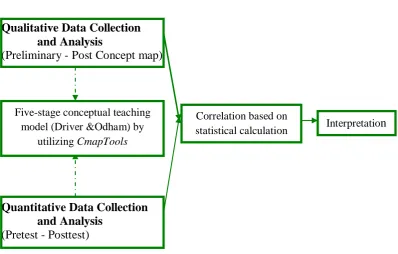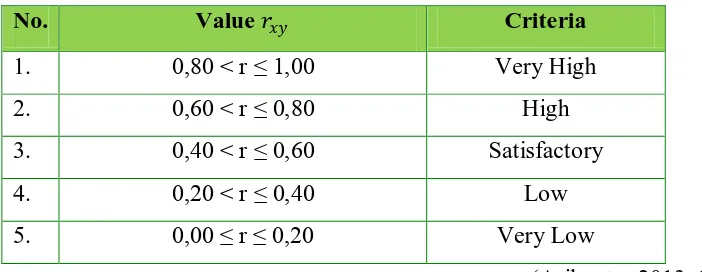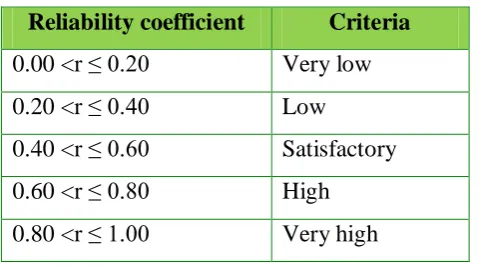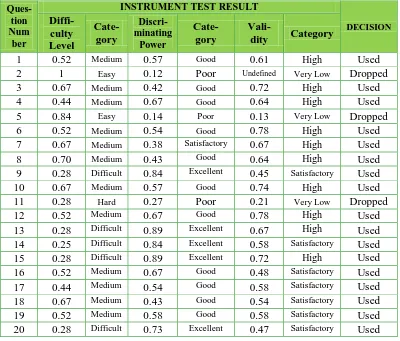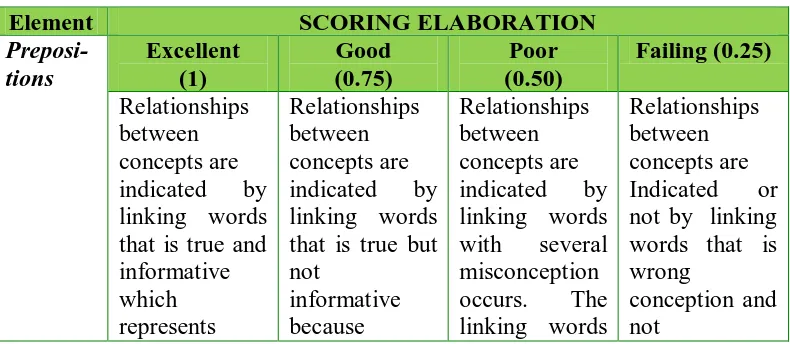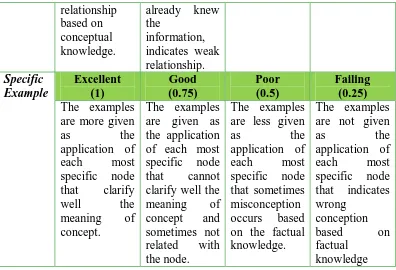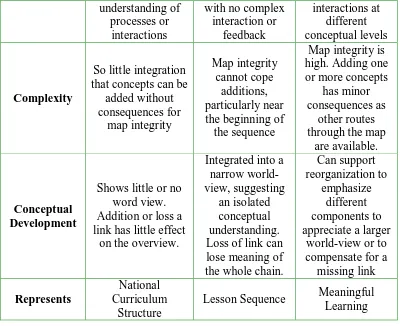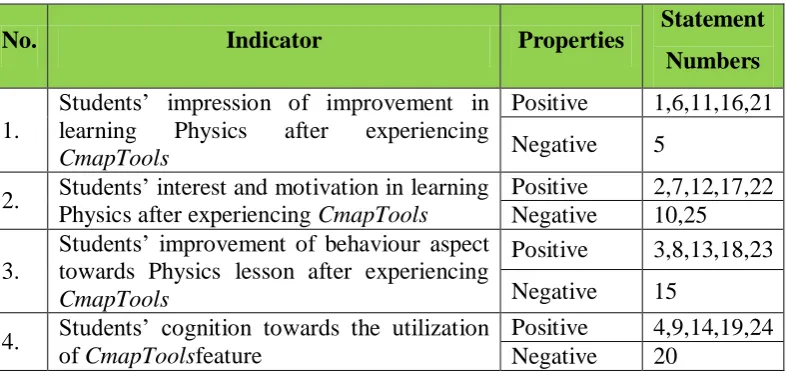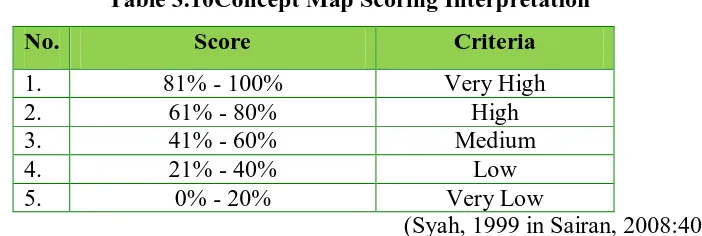APPLICATION OF FIVE-STAGE CONCEPTUAL TEACHING MODEL BY UTILIZING CMAPTOOLS TO ANALYZE CONCEPTUAL CHANGE AND COGNITIVE LEARNING
OUTCO
MES ON LIGHT AND OPTICS TOPIC
RESEARCH PAPER
Submitted as requirement to obtain degree of SarjanaPendidikan in International Program on Science Education study program
Arranged By:
Muhammad RifqiRofiuddin 1002326
INTERNATIONAL PROGRAM ON SCIENCE EDUCATION FACULTY OF MATHEMATICS AND SCIENCE EDUCATION
INDONESIA UNIVERSITY OF EDUCATION BANDUNG
Application of Five-Stage Conceptual Teaching Model by Utilizing
CmapTools to Analyze Conceptual Change and Cognitive Learning
Outco
mes on Light and Optics Topic
Oleh
MiuhammadRifqiRofiuddim
Sebuahskripsi yang
diajukanuntukmemenuhisalahsatusyaratmemperolehgelarSarjanapadaFakultasPen didikanMatematikadanIlmuPengetahuanAlam
© Muhammad RifqiRofiuddin 2014 UniversitasPendidikan Indonesia
Agustus 2014
HakCiptadilindungiundang-undang.
vi Muhammad Rifqi Rofiuddin, 2014
Application Of Five-Stage Conceptual Teaching Model By Utilizing Cmaptools To Analyze Conceptual Change And Cognitive Learning Outcomes On Light And Optics Topic
Universitas Pendidikan Indonesia | repository.upi.edu | perpustakaan.upi.edu TABLE OF CONTENTS
DECLARATION ... i
ABSTRACT ... ii
PREFACE ... iii
TABLE OF CONTENTS ... vi
LIST OF FIGURES ... viii
LIST OF TABLES ... xii
LIST OF APPENDICES ... xiv
CHAPTER I INTRODUCTION ... 1
A. Background ... 1
B. Research Problem ... 5
C. Research Questions ... 5
D. Limitation of Problems ... 6
E. Research Objectives ... 7
F. Research Benefits ... 7
CHAPTERCONCEPTUAL CHANGE, CONCEPT MAP, CMAPTOOLS,COGNITIVE LEARNING OUTCOMES, LIGHT AND OPTICS ... 9
A. Concept, Conception and its Acquisition Process ... 9
B. Conceptual Change ... 11
C. Concept Map for Mapping Conceptual Change ... 16
D. CmapTools for Facilitating Concept Maps Construction ... 20
E. Cognitive Learning Outcomes ... 24
vii Muhammad Rifqi Rofiuddin, 2014
Application Of Five-Stage Conceptual Teaching Model By Utilizing Cmaptools To Analyze Conceptual Change And Cognitive Learning Outcomes On Light And Optics Topic
Universitas Pendidikan Indonesia | repository.upi.edu | perpustakaan.upi.edu
G. Assumptions ... 37
H. Hypothesis ... 37
CHAPTER III METHODOLOGY ... 38
A. Location and Subject ... 38
B. Research Method and Design ... 38
C. Operational Definition ... 40
D. Research Instrument ... 41
E. Instrument Development and Analysis ... 42
F. Data Collection Technique ... 49
G. Data Processing and Analysis ... 54
H. Research Procedure... 60
I. Research Scheme ... 65
CHAPTER IV RESULT AND DISCUSSION ... 66
A. Research Results ... 66
B. Research Discussion ... 79
CHAPTER V CONCLUSION AND SUGGESTION ... 128
A. Conclusion ... 128
B. Suggestion ... 129
REFERENCES ... 130
APPENDICES ... 134
viii Muhammad Rifqi Rofiuddin, 2014
Application Of Five-Stage Conceptual Teaching Model By Utilizing Cmaptools To Analyze Conceptual Change And Cognitive Learning Outcomes On Light And Optics Topic
Universitas Pendidikan Indonesia | repository.upi.edu | perpustakaan.upi.edu LIST OF FIGURES
Figure 2.1 The Five-Stage Conceptual Teaching Model ... 15
Figure 2.2 Concept Map Structure ... 18
Figure 2.3 CmapTools Interface ... 21
Figure 2.4 CmapToolsUtilization for Linking Concept Node to Many Resources ... 22
Figure 2.5 Rectilinear Experiment ... 29
Figure 2.6 Law of Light Reflection ... 30
Figure 2.7 Specular and Diffuse Reflection... 31
Figure 2.8 Elements of Curved Mirror ... 31
Figure 2.9 Three Special Rays in Curved Mirror ... 32
Figure 2.10 Image formation of concave and convex mirror in front of Focal point ... 34
Figure 2.11 Three Special Rays in Convex and Concave Lens ... 36
Figure 2.12 Image formation of concave and convex lens behind Focal Point .. 36
Figure 3.1 Convergent Parallel Design ... 40
Figure 3.2 Diagram of Research Scheme ... 65
ix Muhammad Rifqi Rofiuddin, 2014
Application Of Five-Stage Conceptual Teaching Model By Utilizing Cmaptools To Analyze Conceptual Change And Cognitive Learning Outcomes On Light And Optics Topic
Universitas Pendidikan Indonesia | repository.upi.edu | perpustakaan.upi.edu
Figure 4.2 Graph of Students’ Conceptual Change based on Percentage Score of Preliminary and Post Concept Map in eachNovak and Gowin’s Criteria ... 68
Figure 4.3 Graph of Students’ Concept Map Structure based on Preliminary and Post Concept Map ... 69 Figure 4.4 Improvement of Map Structure of Student 15 ... 70 Figure 4.5 The Ability of Student 15 in Visualizing Concept Node by
Linking to Videos and Interactive Flash. ... 71 Figure 4.6 Graph of Students’ Cognitive Improvement in Learning Light
and Optics after CmapTools Utilization. ... 73 Figure 4.7 Graph of Students’ Improvement in Four-Leveled Cognitive
Domain. ... 74 Figure 4.8 Graph of Students’ Response towards CmapTools utilization. ... 78 Figure 4.9 Comparison of Preliminary and Post Concept Map of
Student 3. ... 91 Figure 4.10 Comparison of Preliminary and Post Concept Map of
Student 5. ... 92 Figure 4.11 Comparison of Preliminary and Post Concept Map of
Student 10. ... 93 Figure 4.12 Comparison of Preliminary and Post Concept Map of
Student 13 ... 94 Figure 4.13 Comparison of Preliminary and Post Concept Map of
x Muhammad Rifqi Rofiuddin, 2014
Application Of Five-Stage Conceptual Teaching Model By Utilizing Cmaptools To Analyze Conceptual Change And Cognitive Learning Outcomes On Light And Optics Topic
Universitas Pendidikan Indonesia | repository.upi.edu | perpustakaan.upi.edu Figure 4.14 Comparison of Preliminary and Post Concept Map of
Student 16. ... 96 Figure 4.15 Comparison of Preliminary and Post Concept Map of
Student 22. ... 97 Figure 4.16 Comparison of Preliminary and Post Concept Map of
Student 1. ... 105 Figure 4.17 Comparison of Preliminary and Post Concept Map of
Student 4. ... 106 Figure 4.18 Comparison of Preliminary and Post Concept Map of
Student 9 ... 107 Figure 4.18 Comparison of Preliminary and Post Concept Map of
Student 9 ... 107 Figure 4.19 Comparison of Preliminary and Post Concept Map of
Student 12 ... 108 Figure 4.20 Comparison of Preliminary and Post Concept Map of
Student 17 ... 109 Figure 4.21 Comparison of Preliminary and Post Concept Map of
Student 18 ... 110 Figure 4.22 Comparison of Preliminary and Post Concept Map of
xi Muhammad Rifqi Rofiuddin, 2014
Application Of Five-Stage Conceptual Teaching Model By Utilizing Cmaptools To Analyze Conceptual Change And Cognitive Learning Outcomes On Light And Optics Topic
Universitas Pendidikan Indonesia | repository.upi.edu | perpustakaan.upi.edu Figure 4.23 Comparison of Preliminary and Post Concept Map of
Student 2 ... 116 Figure 4.24 Comparison of Preliminary and Post Concept Map of
Student 6 ... 117 Figure 4.25 Comparison of Preliminary and Post Concept Map of
Student 7 ... 118 Figure 4.26 Comparison of Preliminary and Post Concept Map of
Student 8 ... 119 Figure 4.27 Comparison of Preliminary and Post Concept Map of
Student 11 ... 120 Figure 4.28 Comparison of Preliminary and Post Concept Map of
Student 19 ... 121 Figure 4.29 Comparison of Preliminary and Post Concept Map of
xii Muhammad Rifqi Rofiuddin, 2014
Application Of Five-Stage Conceptual Teaching Model By Utilizing Cmaptools To Analyze Conceptual Change And Cognitive Learning Outcomes On Light And Optics Topic
Universitas Pendidikan Indonesia | repository.upi.edu | perpustakaan.upi.edu LIST OF TABLES
Table 2.1 Core Competence and Basic Competence of Light and Optics
...28
Table 3.1 Interpretation of Difficulty Level ...43
Table 3.2 Interpretation of Discriminator Power ...44
Table 3.3 Interpretation of Validity ...45
Table 3.4 Interpretation of Reliability ...46
Table 3.5 Recapitulation of Test Item for Students’ Cognitive Outcomes ...47
Table 3.6 Concept Map Scoring Rubric ...49
Table 3.7 Concept Map Structure Rubric ...51
Table 3.8 Blueprint of Objective Questions to Measure Cognitive Learning Outcomes...52
Table 3.9 Blueprint of Students’ Response Questionnaire ...54
Table 3.10 Concept Map Scoring Interpretation ...55
Table 3.11 Category Scale of Students’ Score ...55
Table 3.12 Criteria of N Gain Improvement ...57
Table 3.13 Scoring Guideline of Students’ Response...58
Table 3.14 Percentage Interpretation of Questionnaire...58
xiii Muhammad Rifqi Rofiuddin, 2014
Application Of Five-Stage Conceptual Teaching Model By Utilizing Cmaptools To Analyze Conceptual Change And Cognitive Learning Outcomes On Light And Optics Topic
Universitas Pendidikan Indonesia | repository.upi.edu | perpustakaan.upi.edu
Table 4.1 Recapitulation of Students’ Conceptual Change based on
Preliminary and Post Concept Map Scoring ...67 Table 4.2 Recapitulation Students’ Score of Preliminary and Post Concept
Map based on Novak and Gowin’s Criteria ...68
Table 4.3 Recapitulation of Students’ Concept Map Structure ...69 Table 4.4 Recapitulation of Students’ Cognitive Learning Outcomes based on Statistical Test ...72 Table 4.5 Recapitulation of Students’ Cognitive Domain based on
Anderson’s Taxonomy ...73
Table 4.6 Result of Correlation Between Students’ Conceptual Change and Cognitive Learning Outcomes after experiencing CmapTools Utilization ...76
xiv Muhammad Rifqi Rofiuddin, 2014
Application Of Five-Stage Conceptual Teaching Model By Utilizing Cmaptools To Analyze Conceptual Change And Cognitive Learning Outcomes On Light And Optics Topic
Universitas Pendidikan Indonesia | repository.upi.edu | perpustakaan.upi.edu LIST OF APPENDICES
A. INSTRUCTIONAL TOOLS ... 134
A.1. LESSON PLAN ... 134
1. Lesson Plan 1stMeeting... 134
2. Lesson Plan 2ndMeeting ... 136
3. Lesson Plan 3rd Meeting ... 139
4. Lesson Plan 4thMeeting ... 142
A.2. WORKSHEET ... 144
1. Worksheet 2ndMeeting ... 144
2. Worksheet 3rdMeeting ... 147
B. RESEARCH INSTRUMENT ... 149
B.1. Objective Test of Light and Optics... 149
B.2. Questionnaire towadsCmapTools Utilization ... 158
B.3. Expert Concept Map ... 161
B.4. Observation Sheet ... 162
B.5. Preliminary Study Instruments ... 169
C. INSTRUMENT JUDGEMENT AND TRIAL ... 172
C.1. Analysis of Objective Test ... 172
C.2. Analysis of Expert Concept Map ... 186
C.3. Objective Test Validation Results ... 190
D. RESEARCH DATA RESULTS ... 192
D.1. Recapitulation of Five-Stage Conceptual Teaching Model Learning Activities 192 D.2. Data Distribution of Preliminary Concept Map ... 196
D.3. Data Distribution of Post Concept Map ... 197
D.4. Data Distribution of Pretest ... 198
D.5. Data Distribution of Posttest ... 199
xv Muhammad Rifqi Rofiuddin, 2014
Application Of Five-Stage Conceptual Teaching Model By Utilizing Cmaptools To Analyze Conceptual Change And Cognitive Learning Outcomes On Light And Optics Topic
Universitas Pendidikan Indonesia | repository.upi.edu | perpustakaan.upi.edu
D.7. Normalized Gain Recapitulation of C1 (Remembering) Aspect ... 201
D.8. Normalized Gain Recapitulation of C2 (Understanding) Aspect ... 202
D.9. Normalized Gain Recapitulation of C3 (Applying) Aspect... 203
D.10. Normalized Gain Recapitulation of C4 (Analyzing) Aspect ... 204
D.11. Normality Test Result ... 205
D.12. Hypothesis Test Result ... 206
D.13. Data Distribution of Students’ Worksheet ... 207
D.14. Recapitulation of Students’ Response TowardsCmapToolsUtilization 208 D.15. Preliminary Study (Questionnaire Results) ... 210
D.16. Preliminary Study (Teacher Interview Results) ... 211
E. RESEARCH ADMINISTRATION ... 213
E.1. Research Permission Letter ... 213
E.2. Statement Letter of Research Completion ... 214
Muhammad Rifqi Rofiuddin, 2014
Application Of Five-Stage Conceptual Teaching Model By Utilizing Cmaptools To Analyze Conceptual Change And Cognitive Learning Outcomes On Light And Optics Topic
Universitas Pendidikan Indonesia | repository.upi.edu | perpustakaan.upi.edu
APPLICATION OF FIVE-STAGE CONCEPTUAL TEACHING MODEL BY UTILIZING CMAPTOOLS TO ANALYZE CONCEPTUAL CHANGE AND
COGNITIVE LEARNING OUTCOMES ON LIGHT AND OPTICS TOPIC
Muhammad RifqiRofiuddin
International Program on Science Education
ABSTRACT
Science teachers need to help students identify their prior ideas and modify them based on scientific knowledge. This process is called as conceptual change. One of essential tools to analyze students’ conceptual change is by using concept map. Concept Maps are graphical representations of knowledge that are comprised of concepts and the relationships between them. Constructing concept map is implemented by adapting the role of technological information and communication, as it is suitable with Educational Ministry Regulation No.68 year 2013 that stated the aids of multimedia to support learning process.Institute for Human and Machine Cognition (IHMC) has developed CmapTools, a client-server software for easily construct and visualize concept maps. This research aims to investigate secondary students’ conceptual change and cognitive learning outcomes after experiencing five-stage conceptual teaching model by utilizingCmapTools in learning Light and Optics. Convergent parallel mixed method is implemented in order to collect and assess conceptual change as qualitative data and cognitive learning outcomes as quantitative data. Sample was taken purposively (n= 22 students)at grade VIII in an International School Bandung, West Java. Conceptual change based on comparison of preliminary and post concept map construction is assessed based on rubric of concept map scoring and structure whereas cognitive learning outcomes is assessed based on normality gain in each cognitive level from C1 (remembering) until C4 (analyzing) aspect. Results shows significance conceptual change differences at 50.92 % that is elaborated into concept map element based on Novak and Gowin’s criteria such as prepositions and hierarchical level in high category, cross links in medium category and specific examples in low category. Strong correlation coefficient (rxy= 0.78) illustrates the implementation of five-stage conceptual teaching model by utilizingCmapTools in helping students to construct concept map is capable to improve secondary students’ cognitive learning outcomes in high category that is obtained based on normalized gain value <g = 0.86>. All of the results are supported with the students’ positive response towards CmapTools utilization that indicates improvement of motivation, interest, and behavior aspect towards Physics lesson.
Muhammad Rifqi Rofiuddin, 2014
Application Of Five-Stage Conceptual Teaching Model By Utilizing Cmaptools To Analyze Conceptual Change And Cognitive Learning Outcomes On Light And Optics Topic
Universitas Pendidikan Indonesia | repository.upi.edu | perpustakaan.upi.edu
APLIKASI MODEL LIMA TAHAP PEMBELAJARAN KONSEPTUAL DENGAN PENERAPAN CMAPTOOLS UNTUK MENGANALISIS PERUBAHAN KONSEP
DAN HASIL BELAJAR KOGNITIF PADA TOPIK CAHAYA DAN OPTIK
Muhammad RifqiRofiuddin
International Program on Science Education
ABSTRAK
sebagaimanatertuangdalamPeraturanMenteriPendidikan No. 68 tahun 2013 yang menyatakanpenggunaan multimedia dalam proses pembelajaran. Institute for Human and Machine Cognition (IHMC) telahmengembangkanCmapTools,
sebuah software berbasisklien server yang
memberikankemudahandalammemvisualisasikonsep.Penelitianinibertujuanuntuk menginvestigasiperubahankonseptualdanhasilbelajarkognitifsiswamelalauiimplem
entasi model
pembelajarankonseptuallimatahapdenganmenerapkanCmapToolspadatopikCahaya danOptik. ImplementasiMixed method berbasiskonvergen parallel dimaksudkanuntukmengumpulkandanmengevaluasisecarabersamaperubahankons eptualsebagai data kualitatifdanhasilbelajarkognitifsebagai data kuantitatif.Sampelpenilitiandiambilsecarapurposif (n=22) padakelas VIII di
sebuahSekolahInternasional, Bandung, Jawa Barat.
Perubahankonseptualberdasarkanperbandingankonstruksipetakonsepsebelumdans esudahdievaluasimelaluirubrikskoringdanstruktur,
sedangkanhasilbelajarkognitifdaripretesdanposttesdievaluasimelalui gain ternormalisasipadatiaptahapankognitifdari C1 (mengingat) hingga C4 (menganalisis).Hasilmenunjukkanperbedaankonseptual yang signifikansebesar 50.92% yang dielaborasiberdasarkankriteriapetakonsepmenurut Novak danGowinyaituhubungandanstrukturhirarkipadakategoritinggi,
hubungansilangpadakatergorisedang, dancontohpadakategorirendah.
Besarnyanilaikoefisienkorelasi (rxy=
Muhammad Rifqi Rofiuddin, 2014
Application Of Five-Stage Conceptual Teaching Model By Utilizing Cmaptools To Analyze Conceptual Change And Cognitive Learning Outcomes On Light And Optics Topic
Universitas Pendidikan Indonesia | repository.upi.edu | perpustakaan.upi.edu
1
Muhammad Rifqi Rofiuddin, 2014
Application Of Five-Stage Conceptual Teaching Model By Utilizing Cmaptools To Analyze Conceptual Change And Cognitive Learning Outcomes On Light And Optics Topic
Universitas Pendidikan Indonesia | repository.upi.edu | perpustakaan.upi.edu CHAPTER I
INTRODUCTION
A. Background
Students are viewed as goal-directed agents who actively seek information as it is stated based on Piaget (1978) that they come to formal education with prior knowledge, skills, beliefs and concepts that significantly influence what they notice about the environment and how to organize and interpret it in order to develop their thinking process. The process of transferring knowledge especially during teaching and learning science is focused on the completion of thinking pattern as stated on Educational Ministry Regulation No.68 year 2013 that involves nine main aspects such based on student-centred approach, interactive learning, network based learning, active learning, team-based learning, multimedia based learning,independent learning based on students’ needs, multidiscipline that integrate essentials knowledge and critical learning.
2
Muhammad Rifqi Rofiuddin, 2014
Application Of Five-Stage Conceptual Teaching Model By Utilizing Cmaptools To Analyze Conceptual Change And Cognitive Learning Outcomes On Light And Optics Topic
Universitas Pendidikan Indonesia | repository.upi.edu | perpustakaan.upi.edu
In the implementation of science teaching and learning, those expectations are not promising. According to preliminary study that is conducted by the researcher that aims to figure out students’ problem in learning Physics, it is obtained that most of students find several obstacles and difficulties that describes by these statements:
1. Based on the average of mid-term Physics exam results, it is obtained that only three students or 13.64% pass the criterion standard at 80 whereas the rest of them or 86.36% have score below.
2. Majority of Students state that physics lesson is extremely difficult that covers 86.36% from total twenty two respondents whereas 13.64% feel also that physics lesson is difficult.
3. Several factors that underlineddifficulties in learning Physics such as low motivation in learning is stated by 9.09% of students as well as high achievement standards, inclusion of complicated formulas is stated by 18.18% of students, and mostly students thinkthat lack of learning media involvement is considered as main factor that covers 63.64% of total respondents.
4. Students cannot be independent to construct their own idea because they prefer to learn in group based learning as stated on questionnaire result that covers 59.09%.
5. Students’ motivation in learning is low that is indicated by their response of 72.73% that states willingness to review Physics material only while exam is announced as well as 22.73% of students review only if there is homework or group assignment.
6. The learning environment is not supported as stated by 77.23% students that feel boring to conduct the lesson.
3
Muhammad Rifqi Rofiuddin, 2014
Application Of Five-Stage Conceptual Teaching Model By Utilizing Cmaptools To Analyze Conceptual Change And Cognitive Learning Outcomes On Light And Optics Topic
Universitas Pendidikan Indonesia | repository.upi.edu | perpustakaan.upi.edu
specific software in order to visualize concept. The role of teacher during instructional process is also dominant because teacher often uses speech with the lack of discussion process that is stated by 59.09% students. After doing self-reflection as stated on interview result, teacher thinks that inappropriate teaching method and media is considered as main factor of lower cognitive outcomes although remedial program is already conducted.
Two main problems underline students’ low achievement results based on preliminary study through questionnaire and teacher interview. These problems are classified into two; the inappropriate method and time for students to construct their own concept and the lack use of learning media in science teaching and learning process. In order to overcome those problems; method based on constructivism is essential in order to improve students’ independence in learning as well as thinking process. Students actively construct new information by making use of their prior knowledge and experience; therefore they construct their own understanding through the interaction with the physical and social environment (Liang and Gabel, 2005). Therefore, learning processdevelops students strongly held assumptions or ideas that are not consistent with accepted scientific understanding (Posner et.al, 1982). As a result, science teaching and learning must address these ideas.
4
Muhammad Rifqi Rofiuddin, 2014
Application Of Five-Stage Conceptual Teaching Model By Utilizing Cmaptools To Analyze Conceptual Change And Cognitive Learning Outcomes On Light And Optics Topic
Universitas Pendidikan Indonesia | repository.upi.edu | perpustakaan.upi.edu
acquisition and accommodation of new knowledge as maps are modified over time (Kern and Crippen, 2008).
Constructing concept map can be implemented by adapting the role of technological information and communication, as it is suitable with Educational Ministry Regulation No.68 year 2013 that stated the aids of multimedia to support learning process.Bennett, 2003 (in Qarerah, 2010) explains that as technology has become ever central to schooling, assessing students via technology-based methods will be increasingly required.With the help of ICT tools such as computer and software, complex Physics concepts can be visualized statically or dynamically i.e, graphic animation (Utariet al, 2013).
Institute for Human and Machine Cognition (IHMC) has developedCmapTools, softwarethat provide many capabilities for the creation of concept maps including highly intuitive, modeless editor and the ability to connect links into several trusted resources through serves (Canasetal. 2003). This software is designed based on client-server architecture that allows users to browse and share concept map that is stored in CmapServers distributed throughout the network by supporting synchronous and asynchronouscollaboration (Granados, 2003). Synchronous collaboration through CmapTools allows two users to construct concept maps simultaneously in spite of at different place, meanwhile asynchronous collaboration through CmapToolsis existed by the role of Concept Map sharing and Knowledge Soups that allow users to add or modify annotations and discussion threads (Canaset al. 2003).The knowledge soups that is stored in CmapServer allows students from distant schools to share claims (propositions) derived from their concept maps regarding with any domain of knowledge being studied (Canaset al. 2003).
5
Muhammad Rifqi Rofiuddin, 2014
Application Of Five-Stage Conceptual Teaching Model By Utilizing Cmaptools To Analyze Conceptual Change And Cognitive Learning Outcomes On Light And Optics Topic
Universitas Pendidikan Indonesia | repository.upi.edu | perpustakaan.upi.edu
map to another (Canaset al. 2003). CmapTools also provide beneficial features that allows user to easily construct knowledge model; a set of concept maps and associated resources about a particular domain of knowledge (Canaset al. 2003). Users can create concept map based on their conceptual understanding by establishing informative linking words and cross links, therefore publish and share them through CmapServers, social media or personal websites.
Based on the statement above, it is essential to implement research that able to investigate students’ conceptual change by optimizing the role of technology through CmapTools utilization. Conceptual change can be investigated under conceptual teaching strategy that involves concept acquisition process by modifying students’ prior conception. Therefore, the researcher has intention to conduct research entitles, “Application of Five-Stage Conceptual Teaching Model by Utilizing CmapToolsto AnalyzeConceptual Change and Cognitive
Learning Outcomes on Light and Optics Topic.”
B. Research Problem
According to the background which has already stated, the problem of this research is formulated into: “How is secondary student’s conceptual change and cognitive learning outcomes after experiencing five-stage conceptual teaching model by utilizing CmapToolsin learning Light and Optics?”
C. Research Questions
Based on the research problem that has been stated before, there are several specific questions that come up to be answered by the results of this study, as follow:
6
Muhammad Rifqi Rofiuddin, 2014
Application Of Five-Stage Conceptual Teaching Model By Utilizing Cmaptools To Analyze Conceptual Change And Cognitive Learning Outcomes On Light And Optics Topic
Universitas Pendidikan Indonesia | repository.upi.edu | perpustakaan.upi.edu
2. How is the improvement of secondary students’ cognitive learning outcomes in learning Light and Optics after utilizing CmapToolsunder five-stage conceptual teaching model?
3. How is the correlation of secondary students’ conceptual change by utilizing CmapTools towards cognitive learning outcomes in learning Light and Optics?
4. How is student’s response towards CmapTools utilization in learning Light and Optics?
D. Limitation of Problem
The problem stated is limited to the aspects as follow:
1. Conceptual change based on students’ preliminary and post concept map is limited on quantitative and qualitative domain. Quantitative domain deals with concept map validity that covers four main aspects; relationship, hierarchy level, cross link, and examples (Novak, 1984 in Karakuyu, 2010) based on scoring rubric that is developed by researcher together with experts, whereas qualitative aspect deals with form of concept map into spoke, chain or net (Kinchin et. al., 2000) as well as indication of misconception including the acquisition and accommodation of new knowledge (Kern and Crippen, 2008).
2. Cognitive learning outcomes that is measured in this research is limited into C1 level (remembering), C2 level (understanding), C3 level (applying), and C4 level (analyzing) based on Anderson’s and Krathwohl'sTaxonomy.
3. Students’ response towards CmapTools utilization is limited into four indicators that is arranged based on students’ internal factors towards Physics lesson.
7
Muhammad Rifqi Rofiuddin, 2014
Application Of Five-Stage Conceptual Teaching Model By Utilizing Cmaptools To Analyze Conceptual Change And Cognitive Learning Outcomes On Light And Optics Topic
Universitas Pendidikan Indonesia | repository.upi.edu | perpustakaan.upi.edu
refraction including refraction in lenses as well as nature of image formation in various distance using geometrical optic formula in curved mirror and lenses, also the application of mirror and lenses in daily life. Deeper comprehension of interference, diffraction pattern andpolarization of light waves will not be investigated since those are classified into advance concepts that might produce confusion and further misconception for secondary level.
E. Research Objectives
According to research problems and questions that are stated above, this research aims to investigate several aspects as follow:
1. Investigate significance of secondary student’s conceptual change in Learning Light and Opticsby comparing preliminary and post concept map construction through quantitative and qualitative analysis.
2. Investigate secondary students’ improvement of cognitive learning outcomes in learning Light and Optics by comparing pretest and posttest results through quantitative analysis.
3. Analyze the correlation between secondary students’ conceptual change and cognitive learning outcomes.
4. Investigate secondary students’ response towards CmapTools utilization in facilitating concept map construction.
F. Research Benefits
It is expected that the results of this study ableto conquer these following benefit aspects:
8
Muhammad Rifqi Rofiuddin, 2014
Application Of Five-Stage Conceptual Teaching Model By Utilizing Cmaptools To Analyze Conceptual Change And Cognitive Learning Outcomes On Light And Optics Topic
Universitas Pendidikan Indonesia | repository.upi.edu | perpustakaan.upi.edu
comprehension by constructing concept maps with great validity. The role of CmapTools is possible to improve their interest while learning physics’ concept that deals with daily life phenomena, so that they are able to achieve better result of cognitive outcomescompared to traditional teaching method.
2. For students, along with the existence of this research, they can feel new experience in constructing concept map using CmapTools for making interconnection and interrelation within one concept and another. Students will experience deeper concept mastery that prevents memorizing; because CmapToolsprovides constructive idea for students to dig scientific concepts as well as benefits in visualizing concepts.
3. For other researchers, this study may use as precious references in analyzing how CmapToolsaffectsthe significance of students’ conceptual change and cognitive learning outcomes as well as response towards physics lesson by understanding research treatment and essential instruments in supporting better results such as concept map scoring rubric and physics pretest and posttest questions with good discrimination power, difficulty level, validity and reliability based on Anderson’s Taxonomy. 4. For further research, it is expected to analyze CmapTools utilization for
38
Muhammad Rifqi Rofiuddin, 2014
Application Of Five-Stage Conceptual Teaching Model By Utilizing Cmaptools To Analyze Conceptual Change And Cognitive Learning Outcomes On Light And Optics Topic
Universitas Pendidikan Indonesia | repository.upi.edu | perpustakaan.upi.edu CHAPTER III
RESEARCH METHODOLOGY
A. Location and Subject
1. Research Location and Period
The research was conducted at International School in Bandung, West Java that applied 2013 Curriculum during instructional process. Data is obtained in the period of May until June 2014.
2. Population and Sample
Population is defined as generalization consists of objects or subjects that cover whole quality and specific properties; meanwhile sample is a part of whole quality and specific properties of population (Sugiyono, 2008:118)
The population of this research is all of students’ significance in conceptual change and cognitive learning outcomes that belongs to all secondary students in the school. Samplings are selected by purposive sample technique since researcher has the specific objective. The sample is all of students’ significance in conceptual change and cognitive learning outcomes under the topic of light and optics that consists of 22 students of VIII Grade.
B. Research Method and Design
1. Research Method
Method that is applied in this research is weak experimental method since only one treatment group is investigated without the involvement of control group (Arikunto, 2010). There will be no control group since it is not appropriate to compare method of concept map construction using prototype-based media with
39
Muhammad Rifqi Rofiuddin, 2014
Application Of Five-Stage Conceptual Teaching Model By Utilizing Cmaptools To Analyze Conceptual Change And Cognitive Learning Outcomes On Light And Optics Topic
Universitas Pendidikan Indonesia | repository.upi.edu | perpustakaan.upi.edu
mapping the preliminary and post concept map is required in order to analyze its relation towards cognitive learning outcomes that is assessed quantitatively through statistical means; therefore mixed method is developed in this research. Research variables are classified into two; independent variable (X) and dependent variable (Y) that is affected by the treatment process. Five-stage conceptual teaching model by utilizing CmapTools is the independent variable, whereas the dependent variable is students’ cognitive learning outcomes.
2. Research Design
Type of mixed method design that is applied in this research is convergent parallel that simultaneously collect both quantitative and qualitative data, merge the data and use the results to understand research problem. The datasets is analyzed separately based on its own indicator in order to make interpretation as to whether the results support or contradict each other that provides a convergence of data sources (Creswell, 2011).
Students’ preliminary and post concept map will be analyzed qualitatively
based on the scoring rubric that is developed by researcher and experts based on Novak’s criteria (1984, in Karakuyu, 2010) including concept map pattern based on Kinchin (1999 in Hay and Adams, 2000). Concept elaboration of each individual that is developed can be analyzed descriptively based on comparison of preliminary and post concept map construction. Qualitative investigation is also
concern on students’ ability in linking concept node to various resources by
utilizing CmapTools to understand their thinking process.
Quantitative analysis focuses on students’ cognitive learning outcomes that is obtained from pretest and posttest result by statistical calculation in order to investigate achievement in each cognitive domain; from C1 (remembering) until C4 (analyzing).
40
Muhammad Rifqi Rofiuddin, 2014
Application Of Five-Stage Conceptual Teaching Model By Utilizing Cmaptools To Analyze Conceptual Change And Cognitive Learning Outcomes On Light And Optics Topic
Universitas Pendidikan Indonesia | repository.upi.edu | perpustakaan.upi.edu
Figure 3.1 below represents the convergent parallel design for better understanding.
Qualitative Data Collection and Analysis
(Preliminary - Post Concept map)
Quantitative Data Collection and Analysis
(Pretest - Posttest)
Figure 3.1 Type of Mixed Method Design; Convergent Parallel (Cresswell, 2012: 541)
C. Operational Definition
Operational definition is required in order to give the clarity of the research that has to be suitable with the expected aims; that described as follows:
1. Conceptual change is the significance change of students’ conception in
learning Light and Optics based on comparison of preliminary and post concept map construction that emphasizes on significance changing of concept map criteria intorelationship, hierarchical structure, cross link and specific example as well as significance changing of concept map structure into spoke, chain or netunder five stage conceptual teaching model consists of orientation, elicitation, restructure, application and review change of ideas. 2. Concept map is a visual set of concepts aims to answer focus question.
According to Novak (1984) concept map is constructed under four elements; Interpretation Five-stage conceptual teaching
model (Driver &Odham) by utilizing CmapTools
41
Muhammad Rifqi Rofiuddin, 2014
Application Of Five-Stage Conceptual Teaching Model By Utilizing Cmaptools To Analyze Conceptual Change And Cognitive Learning Outcomes On Light And Optics Topic
Universitas Pendidikan Indonesia | repository.upi.edu | perpustakaan.upi.edu
such as (1) prepositions is the connection among concept node through the inclusion of meaningful an informative linking words that represents students’ understanding, (2) hierarchical structure based on arrangement from inclusive to exclusive concepts represents concept organization and classification, (3) cross links is the interconnection among concepts in different map segments or domain represents mapping complexity and analysis ability, and (4) example of specific concept node represents concept application.
3. Cognitive learning outcomes is the competencies of students to achieve cognitive dimension after utilizing CmapTools that is determined from C1 (remembering) – C2 (understanding) – C3 (applying) and C4 (analyzing) in learning Light and Optics through pretest and posttest that consists of 25 multiple questions.
4. CmapToolsthat is used in this research is a prototype media developed by IHMC (Institute of Human and Machine Cognition) that aims to mapping
students’ conceptual change based on concept map construction. CmapTools
has benefits to link concept node into various learning resources that is used for qualitative analysis to investigate students’ visual learning.
5. Students’ response towards CmapTools utilization is classified into four
criteria such as; (1) impression of improvement in learning Physics,(2) interest and motivation towards Physics lesson, (3) improvement of behavior aspect towards Physics lesson, and (4) cognition towards the benefits of CmapTools feature.
D. Research Instrument
The research instrument that is applied for collecting data in this research consists of:
1. Significance of students’ conceptual change is analyzed by using rubrics that
42
Muhammad Rifqi Rofiuddin, 2014
Application Of Five-Stage Conceptual Teaching Model By Utilizing Cmaptools To Analyze Conceptual Change And Cognitive Learning Outcomes On Light And Optics Topic
Universitas Pendidikan Indonesia | repository.upi.edu | perpustakaan.upi.edu
and concept map structure rubric (Table 3.7) that aims to analyze changing of map structure that is obtained from preliminary and post concept map construction.
2. Improvement of students’ cognitive learning outcomes is analyzed by implementing objective test (Appendix B.1) in form of multiple questions with four distractors that is obtyained from pretest and posttest.
3. Students’ response towards CmapTools utilization in learning Light and
Optics is analyzed based on unstructured questionnaire form (Appendix B.2) that emphasizes on four indicator such as; (1)impression of improvement in learning Physics, (2) interest and motivation towards Physics lesson, (3) improvement of behavior aspect towards Physics lesson, and (4) cognition towards the benefits of CmapTools feature.
E. Instrument Development and Analysis
Research instruments development is initiated with the content analysis of 2013 curriculum that is used in school. Expert concept map as main reference for scoring students’ concept map for investigating conceptual change has to be developed first by the researcher under suggestion from Physics expert (Appendix B.3). The expert concept map is formulated based on the applicable content that has to be suitable with the ability of secondary students.
43
Muhammad Rifqi Rofiuddin, 2014
Application Of Five-Stage Conceptual Teaching Model By Utilizing Cmaptools To Analyze Conceptual Change And Cognitive Learning Outcomes On Light And Optics Topic
Universitas Pendidikan Indonesia | repository.upi.edu | perpustakaan.upi.edu
accordance with the questions statement. The instrument analysis of objective test requires levels of difficulty, discriminating power validity and reliability.
1. Instrument Test Requirements a. Level of Difficulty
Good quality question has to be arranged in balanced; the proportion should not consist of whole easy or hard questions, since easy question will not stimulate students to spend more effort in answering as well as hard questions will make students desperate and doesn’t have any motivation to solve it (Arikunto, 2013: 222). Consideration of difficulty level is based on proportion of problem categories easy, medium and difficult. The formula to determine levels of difficulty is represented as follow:
.
� = � Where:
P= difficulty level
B = number of students who answer correctly N= Total number of students
(Arikunto, 2013: 224)
Classification of difficulty level based on Arikunto is represented on Table 3.1 as follow:
Table 3.1Interpretation of Difficulty Level
No. Difficulty Value Criteria
1. 0.00 – 0.30 Hard
2. 0.31 – 0.70 Middle
3. 0.71 – 1.00 Easy
44
Muhammad Rifqi Rofiuddin, 2014
Application Of Five-Stage Conceptual Teaching Model By Utilizing Cmaptools To Analyze Conceptual Change And Cognitive Learning Outcomes On Light And Optics Topic
Universitas Pendidikan Indonesia | repository.upi.edu | perpustakaan.upi.edu b. Discriminating Power
Discriminating power is defined as the ability of particular question to distinguish students who classified as higher achievement and lower achievement. The amount of higher achievement students who can answer more particular questions compared to lower achievement means that those questions have positive discriminating power index (Arikunto, 2013: 226). Discriminating power index shows the scale from minus one until positive one, with the negative represents lower discriminating power index and vice versa. The formula to determine the discriminating power is represented below followed by criteria as seen on Table 3.2
DP =
�
−
�Where:
DP = Discriminating Power
Ba = The number of upper group that answer correctly Ja = Total of students in upper group
Bb = The number of upper group that answer incorrectly Jb = Total of students in lower group
(Arikunto, 2013: 228)
Table 3.2Interpretation of Discriminator Power No. Discriminating Power Value Criteria
1. 0.00 – 0.20 Poor
2. 0.21 – 0.40 Satisfactory
3. 0.41 – 0.70 Good
4. 0.71 – 1.00 Excellent
(Arikunto, 2013: 232)
45
Muhammad Rifqi Rofiuddin, 2014
Application Of Five-Stage Conceptual Teaching Model By Utilizing Cmaptools To Analyze Conceptual Change And Cognitive Learning Outcomes On Light And Optics Topic
Universitas Pendidikan Indonesia | repository.upi.edu | perpustakaan.upi.edu
…….. (3.3) c. Validity
Validity is defined as the extent to which the instrument measures what it is designed to measure that emphasizes not on the test itself, but on the result (Arikunto, 2013: 80). Validity which is used in this study is Construct Validity since each question item is formulated based on Cognitive Taxonomy. Arikunto (2013:83) describe construct validity measures thinking aspect based on logical; such as classified question item into cognitive dimension. The formula to determine validity is shown below followed by Table 3.3 that interprets the classification of coefficient correlation criteria.
=
−( ) ( )2
−( )2 2−( )2
Where:
= coefficient correlation or item validity
= sum of total score of all students for each question’s item = sum of total score of all students for whole test
N = total number of students
X = score of each student for each question’s item Y = total score of each student
(Arikunto, 2013: 87)
Table 3.3Interpretation of Validity
No. Value Criteria
1. 0,80 < r ≤ 1,00 Very High
2. 0,60 < r ≤ 0,80 High
3. 0,40 < r ≤ 0,60 Satisfactory
4. 0,20 < r ≤ 0,40 Low
5. 0,00 ≤ r ≤ 0,20 Very Low
46
Muhammad Rifqi Rofiuddin, 2014
Application Of Five-Stage Conceptual Teaching Model By Utilizing Cmaptools To Analyze Conceptual Change And Cognitive Learning Outcomes On Light And Optics Topic
Universitas Pendidikan Indonesia | repository.upi.edu | perpustakaan.upi.edu d. Reliability
Reliability is defined as the extent to which a questionnaire, test, observation or any measurement procedure produces the same results on repeated trials. In short, it is the stability or consistency of scores over time or across raters (Arikunto, 2013: 101). The split-half method using KR 20 equation is used to calculate reliability of the test by giving score one for correct answer and zero for wrong answer (Arikunto, 2013: 108).The equation is described as follow:
r
11= (
−1
)(1-
²)
Where:
r11 = instrument reliability k = amount of test item
∑pq = multiplication result of p and q s = deviation standard
The reliability interpretation represents on the table below.
Table 3.4Interpretation of Reliability
(Arikunto, 2013: 109) Reliability coefficient Criteria
0.00 <r ≤ 0.20 Very low
0.20 <r ≤ 0.40 Low
0.40 <r ≤ 0.60 Satisfactory 0.60 <r ≤ 0.80 High 0.80 <r ≤ 1.00 Very high
47
Muhammad Rifqi Rofiuddin, 2014
Application Of Five-Stage Conceptual Teaching Model By Utilizing Cmaptools To Analyze Conceptual Change And Cognitive Learning Outcomes On Light And Optics Topic
Universitas Pendidikan Indonesia | repository.upi.edu | perpustakaan.upi.edu e. Recapitulation of Students’ Cognitive Outcomes Instrument
Objective test for measuring students’ cognitive learning outcomes in form of 30 questions has to be tested in terms of difficulty level, discriminating power, validity and reliability that are given to 25 students grade IX who already gained the material of Light and Optics before. Decision based on test requirement result can be used, dropped, or revised with experts related with the probability of particular question item to be used. The recapitulation of objective test as well as specification for each question item is represented on following table and Appendix C.3 for more distinct result.
Test item recapitulation :
Reliability test : 0. 81 (Very High)
Table 3.5Recapitulation of Test Item for Students’ Cognitive Outcomes
48
Muhammad Rifqi Rofiuddin, 2014
Application Of Five-Stage Conceptual Teaching Model By Utilizing Cmaptools To Analyze Conceptual Change And Cognitive Learning Outcomes On Light And Optics Topic
Universitas Pendidikan Indonesia | repository.upi.edu | perpustakaan.upi.edu
21 0.52 Medium 0.48 Good 0.78 High Used
22 0.67 Medium 0.77 Excellent 0.54 Satisfactory Used 23 0.28 Difficult 0.74 Excellent 0.67 High Used 24 0.44 Medium 0.48 Good 0.42 Satisfactory Used 25 0.81 Easy 0.10 Poor 0.13 Very Low Dropped 26 0.77 Easy 0.12 Poor 0.19 Very Low Dropped
27 0.44 Medium 0.57 Good 0.78 High Used
28 0.52 Medium 0.57 Good 0.53 Satisfactory Used
29 0.67 Medium 0.71 Excellent 0.67 High Used
30 0.52 Medium 0.87 Excellent 0.75 High Used
2. Instrument Non-Test Requirements
a. Rubrics
Concept map scoring and concept map structure are two main rubrics that are applied in this research. Concept map scoring rubric is designed based on Novak and Gowin(1984) that covers four main elements such as preposition, hierarchical level, cross link and example that aims to analyse significance of conceptual change that is obtained from preliminary and post concept map construction. Concept map structure is adapted based on Kinchin and Hay (2000) that concern on the pattern of concept map into spoke, chain or net that represents the conceptual changing. Concept map scoring rubric is elaborated by the
researcher and revised based on related experts’ recommendation that utilizes
scale to calculate students’ concept map score compared to expert concept map.
b. Questionnaire
Questionnaire consists of twenty five positive statements and five negative
statements is used to illustrate students’ response towards CmapToolsutilization in
49
Muhammad Rifqi Rofiuddin, 2014
Application Of Five-Stage Conceptual Teaching Model By Utilizing Cmaptools To Analyze Conceptual Change And Cognitive Learning Outcomes On Light And Optics Topic
Universitas Pendidikan Indonesia | repository.upi.edu | perpustakaan.upi.edu F. Data Collection Technique
Qualitative and quantitative data that is obtained in this research requires different collection technique as well as scoring method. Qualitative data is obtained from preliminary and post concept map construction that empathizes on conceptual change based on significance changing of students’ concept map scoring as well as concept map structure. Meanwhile quantitative data concern on cognitive learning outcomes emphasizes on changing in each cognitive level that is obtained from pretest and posttest. Data collection techniques are explained a follow:
1. Data of Students’ Conceptual Change based on Concept Map Scoring
Students’ conceptual change that is obtained from preliminary and post concept map construction is assessed by Concept map scoring rubric. Scoring based on Novak and Gowin (1984) such valid preposition is one, hierarchical structure is five, cross link is ten, and specific example is one for each meaningful mapping is used as maximum score. Each element is elaborated into four different criteria such as excellent-good-poor-and failing that aims to differentiate each student’s concept map quality after whole preliminary and post concept map is collected. Scoring will be divided by four in order to indicate each indicator that represents different characteristics under discussion with experts.
Table 3.6Concept Map Scoring Rubric
50
Muhammad Rifqi Rofiuddin, 2014
Application Of Five-Stage Conceptual Teaching Model By Utilizing Cmaptools To Analyze Conceptual Change And Cognitive Learning Outcomes On Light And Optics Topic
51
Muhammad Rifqi Rofiuddin, 2014
Application Of Five-Stage Conceptual Teaching Model By Utilizing Cmaptools To Analyze Conceptual Change And Cognitive Learning Outcomes On Light And Optics Topic
Universitas Pendidikan Indonesia | repository.upi.edu | perpustakaan.upi.edu relationship
2. Data of Students’ Conceptual Change based on Concept Map Structure
Significance changing of concept map structure that is obtained from preliminary and post concept map structure represents well restructure of ideas that illustrate how students change their conception. Qualitative approach that aims to investigate concept map pattern for analyzing conceptual change is developed by Kinchin and Hay (2000: 48). They classified concept map structure into spoke, chain and net as seen on Figure 2.2.a, 2.2.b, and 2.2.c that emphasizes on hierarchy level, processes, complexity, conceptual development and representation as seen on Table 3.7 as follow:
Table 3.7Concept Map Structure Rubric
52
Muhammad Rifqi Rofiuddin, 2014
Application Of Five-Stage Conceptual Teaching Model By Utilizing Cmaptools To Analyze Conceptual Change And Cognitive Learning Outcomes On Light And Optics Topic
Universitas Pendidikan Indonesia | repository.upi.edu | perpustakaan.upi.edu understanding of
3. Data of Students’ Cognitive Learning Outcomes
Students’ cognitive learning outcomes in each cognitive level are obtained two times based on pretest and posttest. Test is carried out with the form of multiple choices using 25 test items under the topic of Light and Optics. Objective test is formulated based on factual and conceptual knowledge in the form of multiple choices using four options with the cognitive dimension as C1 (remembering), C2 (Understanding), C3 (Applying), and C4 (Analyzing). The blueprint of the objective test is shown based on table 3.8 below represents proportion for each cognitive level.
Table 3.8Blueprint of Objective Questions
53
Muhammad Rifqi Rofiuddin, 2014
Application Of Five-Stage Conceptual Teaching Model By Utilizing Cmaptools To Analyze Conceptual Change And Cognitive Learning Outcomes On Light And Optics Topic
Universitas Pendidikan Indonesia | repository.upi.edu | perpustakaan.upi.edu straight line based on daily diffusion reflection on the rough surface using diagram.
3 Interpret concept of Law of
Reflection and image formation in plane mirror
4,5 Apply geometrical optic
formula in curved mirror 11,12
Analyze nature of image light refraction indaily life phenomena
6,7 Determine ray between two
mediums with different density based on Snell’s Law
8 Analyse the form of
refraction using ray diagram based on refraction index
9 Apply geometrical optic
formula in lenses
18,19, 21,22 Analyse nature of image
formation in lenses 20,23
Exemplify the principle of
Non-test data instrument using questionnaire is implemented to investigate
students’ response towards CmapToolsutilization in learning Light and Optics.
54
Muhammad Rifqi Rofiuddin, 2014
Application Of Five-Stage Conceptual Teaching Model By Utilizing Cmaptools To Analyze Conceptual Change And Cognitive Learning Outcomes On Light And Optics Topic
Universitas Pendidikan Indonesia | repository.upi.edu | perpustakaan.upi.edu
lesson, (3) improvement of behavior aspect towards Physics lesson, and (4) cognition towards the benefits of CmapTools feature. There are 25 statements with the inclusion of 5 questions that states negative statement in order to control
students’ answer. This attitude scale uses Likert with four points of type scale
(absolutely agree, agree, do not agree, absolutely do not agree) based on Measurement of Successive Interval (MSI) computation. Type of scale which states do not agree is prevented in order to make the clarity of student’s response after experiencing CmapTools. Scoring of positive statement is given point 5 until 1 orderly from strongly agree until strongly disagree criteria; whereas scoring of negative statement is vice versa. The blueprint is represented based on Table 3.9 as follow:
Table 3.9Blueprint of Students’ Response Questionnaire
No. Indicator Properties Statement
Numbers
1.
Students’ impression of improvement in
learning Physics after experiencing CmapTools
Positive 1,6,11,16,21 Negative 5
2. Students’ interest and motivation in learning
Physics after experiencing CmapTools
Positive 2,7,12,17,22 Negative 10,25 3.
Students’ improvement of behaviour aspect
towards Physics lesson after experiencing CmapTools
Positive 3,8,13,18,23 Negative 15
4. Students’ cognition towards the utilization
of CmapToolsfeature
Positive 4,9,14,19,24 Negative 20
G. Data Processing and Analysis
Quantitative and qualitative data that is obtained in this research will be processed in different method of calculation. Qualitative data emphasizes on significance of students’ conceptual change from preliminary and post concept
map construction including students’ response towards CmapTools utilization,
55
Muhammad Rifqi Rofiuddin, 2014
Application Of Five-Stage Conceptual Teaching Model By Utilizing Cmaptools To Analyze Conceptual Change And Cognitive Learning Outcomes On Light And Optics Topic
Universitas Pendidikan Indonesia | repository.upi.edu | perpustakaan.upi.edu
………….. (3.6)
1. Data Processingof Students’ Conceptual Change
Students’ concept map that is obtained twice in preliminary and post
implementation in order to illustrate significance of conceptual change will be assessed based on concept map scoring rubric (Table 3.6). Expert concept map that is already developed by researcher together with Physics expert is used as maximum score. Concept map scoring isrepresented as follow including the score interpretation on Table 3.10.
=
( � ) 100%……. (3.5)
Table 3.10Concept Map Scoring Interpretation
No. Score Criteria
1. 81% - 100% Very High
2. 61% - 80% High
3. 41% - 60% Medium
4. 21% - 40% Low
5. 0% - 20% Very Low
(Syah, 1999 in Sairan, 2008:40) 2. Data Processingof Students’ Cognitive Learning Outcomes
Objective test that consists of 25 multiple questions based on arrngemet of cognitive level from C1 (remember) until C4 (analysing) will be assessed based on scoring. For each correct answer will be given score 1 whereas wrong answer will be given score 0.Scores then will be converted into 0-100 scale value.The score conversion in form percentage (%) represents based on this equation:
Table 3.11Category Scale of Students’ Score
Score Category
S ≤ 40 Very poor
41 ≤ S ≤ 55 Poor
56
Muhammad Rifqi Rofiuddin, 2014
Application Of Five-Stage Conceptual Teaching Model By Utilizing Cmaptools To Analyze Conceptual Change And Cognitive Learning Outcomes On Light And Optics Topic
Universitas Pendidikan Indonesia | repository.upi.edu | perpustakaan.upi.edu
56 ≤ S ≤ 65 Satisfactory
66 ≤ S ≤ 80 Good
81 ≤ S ≤ 100 Excellent
(Arikunto 2013: 281)\
Gain score (actual gain) was obtained from the difference of pre-test score and post-test score. The difference in pre-test scores and the post-test is assumed as the effect of the intervention. Normalized gain calculations are intended to determine the categories of students’ achievement improvement. According to Hake (1999) normalized gain is calculated by using this following formula:
� = −
(Hake, 1999) Where :
G = Gain
= Post-test score = Pre-test score
The improvement of cognitive learning outcomes in learning Light and Opticsafter utilizing CmapToolsfor constructing concept maps will be seen from the result of the normalized gain that achieved by students. For the calculation of the normalized gain value and its classification will use equations as follows:
Where:
<g> = Normalized gain
G = Actual gain
Gmax = Maximum gain possible Sf = Post-test score
Si = Pre-test score
(Hake, 1999) < >= %�
%� =
(% −% ) (100−% )
………….. (3.7)
57
Muhammad Rifqi Rofiuddin, 2014
Application Of Five-Stage Conceptual Teaching Model By Utilizing Cmaptools To Analyze Conceptual Change And Cognitive Learning Outcomes On Light And Optics Topic
Universitas Pendidikan Indonesia | repository.upi.edu | perpustakaan.upi.edu
The value of <g> is determined based on criteria below on the table below:
Table 3.12Criteria of N Gain Improvement N-Gain <g> Improvement Criteria
0,00 – 0,29 Low
0,30 – 0,69 Medium
0,70 – 1,00 High
(Hake, 1999)
3. Data Processing of Students’ Response towards CmapTools Utilization
Qualitative analysis of students’ response is carried out in order to analyze students’ interest, motivation, impression and cognition towards the implementation of using CmapTools in constructing concept map. Processing is executed by calculating Likert scale into score then percentage conversion. The formula of converting score into percentage is seen below followed by scoring guideline of Likert scale that is represented on Table 3.13 as follow:
Score = � ����
�� ���� ���� x 100%
(Arikunto, 2013: 262) Table 3.13Scoring Guideline of Students’ Response
Strongly
Disagree Disagree Not sure Agree
Strongly Agree
Negative Statement 5 4 3 2 1
Positive Statement 1 2 3 4 5
(Sugiyono, 2008: 203) The interpretation of score percentage is categorized into certain criteria according to Arikunto (2013) is represented as follows.
Tabel 3.14Percentage Interpretation of Questionnaire
Percentage(%) Criteria
0% None
0 %- 25% A few of criteria
26%-40% Almost half of
58
Muhammad Rifqi Rofiuddin, 2014
Application Of Five-Stage Conceptual Teaching Model By Utilizing Cmaptools To Analyze Conceptual Change And Cognitive Learning Outcomes On Light And Optics Topic
Universitas Pendidikan Indonesia | repository.upi.edu | perpustakaan.upi.edu
41%-50% Half of
51%- 75% Mostly
76%-99% Generally
100% All of them
(Arikunto, 2013: 263)
4. Data Analysis and Hypothesis Test
a. Normality Test
Parametric statistic is implemented in this research since it aims to measure the parameter of particular sample that has normal distribution. If the distribution is free, non-parametric statistic is used. Parametric statistic is more valid and powerful compared to non-parametric related with interval and ratio data; if the assumptions are reasonably met (Phopan, 1973 in Sugiyono, 2008: 211). Normality test is executed in order to analyze whether samples comes from population that has normal distribution or not. SPSS version 17.0 is used as supporting software to determine normality test for each pretest and posttest based on Kolmogorov-Smirnov. Data is considered as normal distribution if the criterion is higher than assumption of significance in two-tailed.
b. Hypothesis Test
59
Muhammad Rifqi Rofiuddin, 2014
Application Of Five-Stage Conceptual Teaching Model By Utilizing Cmaptools To Analyze Conceptual Change And Cognitive Learning Outcomes On Light And Optics Topic
Universitas Pendidikan Indonesia | repository.upi.edu | perpustakaan.upi.edu Table 3.15Interpretation of Correlation Coefficient
Correlation coefficient (rxy) Interpretation
0,0 – 0,19 Very low
0,20 – 0,39 Low
0,40 – 0,59 Medium
0,60 – 0,79 Strong
0,80 – 1,00 Very strong
(Sugiyono, 2008: 257)
Determination coefficient can be calculated in order to determine the regression equation as represented by the equation as follow:
= 2 × 100%
Where:
R = Determination coefficient r = Correlation coefficient
(Sugiyono, 2008: 259)
Regression analysis aims to obtain the equation that is used to investigate the prediction of high or low dependent variable value (Y) if the independent variable is being modified or manipulated (Sugiyono, 2008: 261). The equation is represented as follow:
= +
Where:
Y = Value that will be predicted a=Constanta or if the X value is zero b = Regression coefficient
X = Value of independent variable
(Sugiyono, 2008: 259)
……….. (4.0)
60
Muhammad Rifqi Rofiuddin, 2014
Application Of Five-Stage Conceptual Teaching Model By Utilizing Cmaptools To Analyze Conceptual Change And Cognitive Learning Outcomes On Light And Optics Topic
Universitas Pendidikan Indonesia | repository.upi.edu | perpustakaan.upi.edu H. Research Procedure
This research is carried out into three stages; preparation, implementation and final stage under conceptual change teaching model according to Driver and Oldham. The stage description will be explained as follows:
1. Preparation stage
In the planning stages consists of preliminary study, literature study, and design the research instrument.
a. Preliminary Study
Preliminary study aims to identify the problem in real Physics classroom environmental system. It is useful to find out obstacles which students faced, so questionnaires have to be distributed. A questionnaire consists of ten questions is given to each student one week before entering the lesson stage. Teacher also are being interviewed about several problems that she faced during teach physics. By analyzing the results of both questionnaires and teacher’s interview, research problem can be formulated.
b. Literature Review
